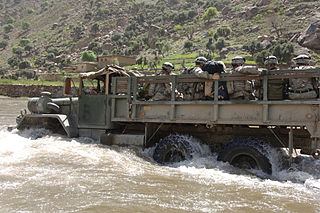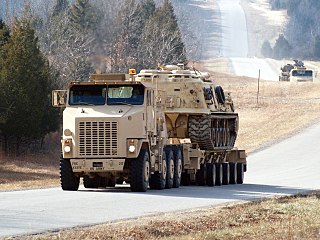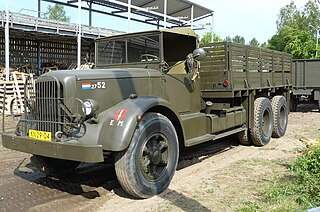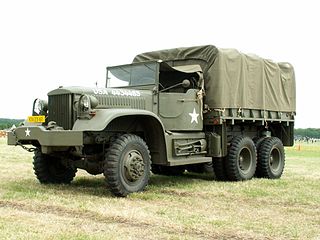
Mack Trucks, Inc., is an American truck manufacturing company and a former manufacturer of buses and trolley buses. Founded in 1900 as the Mack Brothers Company, it manufactured its first truck in 1905 and adopted its present name in 1922. Mack Trucks is a subsidiary of AB Volvo, which purchased Mack along with its then parent company Renault Véhicules Industriels in 2000.

The Studebaker US6 (G630) was a series of 2+1⁄2-ton 6×6 and 5-ton 6×4 trucks manufactured by the Studebaker Corporation and REO Motor Car Company during World War II. The basic cargo version was designed to transport a 2+1⁄2-short-ton cargo load over any type of terrain in any weather. Most of these were exported to the Soviet Union under Lend-Lease by the USA during World War II, since the competing GMC 6×6 CCKW design proved to be more suitable for Western Front conditions.

The M939 is a 5-ton 6×6 U.S. military heavy truck. The basic cargo versions were designed to transport a 10,000 pounds (4,500 kg) cargo load over all terrain in all weather. Designed in the late 1970s to replace the M39 and M809 series of trucks, it has been in service ever since. The M939 evolved into its own family of cargo trucks, dump trucks, semi-tractors, vans, wreckers, and bare chassis/cabs for specialty bodies. 44,590 in all were produced.

The M19 Tank Transporter was a heavy tank transporter system used in World War II and into the 1950s. It consisted of a 12-ton 6x4 M20 Diamond T Model 980 truck and companion 12-wheel M9 trailer.

The M39 series 5-ton 6×6 truck (G744) was a family of heavy tactical trucks built for the United States Armed Forces. The basic cargo version was designed to transport a 5-ton (4,500 kg), 14 ft (4.3 m) long load over all terrain in all weather. In on-road service the load weight was doubled.

The GMC CCKW, also known as "Jimmy", or the G-508 by its Ordnance Supply Catalog nr, was a highly successful series of off-road capable, 21⁄2-ton, 6×6 trucks, built in large numbers to a standardized design for the U.S. Army, that saw heavy service, predominantly as cargo trucks, in both World War II and the Korean War. The original "Deuce and a Half", it formed the backbone of the famed Red Ball Express that kept Allied armies supplied as they pushed eastward after the Normandy invasion.

The M915 is a tractor unit used for line haul missions by the United States Army. Designed for use on improved roads it does not have a driven front axle.

The Mack NO 7+1⁄2-ton 6x6 truck was a heavy 6x6 cargo truck designed in the 1940s by the American manufacturer Mack Trucks. It was used by the U.S. Army as an artillery tractor for heavy artillery during and after World War II. The official U.S. Army designation was: Truck, 7 1/2 ton, 6x6, Prime Mover. Its G-number was (G-532).

The Mack model EH trucks were a family of 4x2 trucks used by the US and British military before and during World War II. They were built in conventional and cab-over-engine models and were used as both trucks and semi-tractors. Originally a commercial design, in 1943 a military version became standard.

The M425 and M426 Tractor trucks (G671) were 5 ton (4,536kg) load rated 4x2 semi-tractors that were used from 1944 on by the US Army. They are famous for the use on the Red Ball Express from Normandy to the front, but were also used in the China Burma India Theater. After the war they were used in Europe, including during the Berlin Crisis, and in the Korean War.

The Mack M123 (G792) was a 10-ton 6x6 semi-tractor introduced in 1955; the Mack M125 was a heavy cargo truck version of the M123. The M123 was used to tow tank transporter trailers while the M125 towed field artillery pieces.

The Autocar Model U8144T, officially "5- to 6-Ton, 4×4, Ponton Tractor Truck", was the largest, and most heavy-duty, of a family of heavy four-wheel drive trucks developed for, and deployed primarily with, the United States Army in World War II. They were of a "cab over engine" design, and produced by the Autocar Company from 1941 to 1945 with 2,711 being built.

Mack Trucks has been selling heavy duty trucks and buses to the United States military since 1911. Virtually every model has been used. The majority have been commercial models designed and built by Mack with their own components, but they have also designed and built military specification tactical trucks. The military vehicles are rated by payload measured in tons.

The M809 Series 5-ton 6x6 truck (G908) was a family of heavy tactical trucks built for the United States Armed Forces. The basic cargo version was designed to transport a 5-ton (4,500 kg), 14 ft (4.3 m) long load over all terrain in all weather. In on-road service the load weight was doubled. Built by AM General, they evolved into the M939 Series.

The 6-ton 6×6 truck was a family of heavy tactical trucks built for the United States Army during World War II. The basic cargo version was designed to transport a 6- short ton (5,400 kg) cargo load over all terrain in all weather. The chassis were built by Brockway Motor Company, The Corbitt Company, The Four Wheel Drive Auto Company (FWD), Ward LaFrance Truck Corporation, and White Motor Company. They were replaced by the M54 5-ton 6x6 trucks in the 1950s.

The 5‑ton 6x6 truck, officially "Truck, 5-ton, 6x6", was a class of heavy-duty six-wheel drive trucks used by the US Armed Forces. The basic cargo version was designed to transport a 5-ton (4,500 kg) load over all roads and cross-country terrain in all weather. Through three evolutionary series there have been component improvements, but all trucks were mechanically very similar. They were the standard heavy-duty truck of the US military for 40 years, until replaced by the Medium Tactical Vehicle (MTV) beginning in 1991.

The Oshkosh M1070 is a U.S. Army tank transporter tractor unit. The primary purpose of this combination for the U.S. Army is the transport of the M1 Abrams tank.

The 2+1⁄2-ton, 6×6 truck was a standard class of medium duty trucks, designed at the beginning of World War II for the US Armed Forces, in service for over half a century, from 1940 into the 1990s. Also frequently known as the deuce and a half, or just deuce, this nickname was popularized post WWII, most likely in the Vietnam war era. The basic cargo versions were designed to transport a cargo load of nominally 2+1⁄2 short tons over all terrain, in all weather. The 2+1⁄2-ton trucks were used ubiquitously in World War II, and continued to be the U.S. standard medium duty truck class after the war, including wide usage in the Korean and Vietnam Wars, as well as the first Gulf War.

The Mack NR was a heavy 6x4 cargo truck designed and produced in the 1940s by the American manufacturer Mack Trucks. It was used mainly by the British Army to transport cargo and materiel over long distances during World War II. The official U.S. Army designation was: Truck, 10 ton, 6x4, Cargo. Its G-number was (G-528).

The Diamond T 4-ton 6×6 truck was a heavy tactical truck built for the United States Army during World War II. Its G-number was G-509. Cargo models were designed to transport a 4-ton (3,600 kg) load over all terrain in all weather. There were also wrecker, dump, and other models. They were replaced by the M39 series 5-ton 6×6 trucks in the 1950s.























